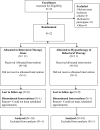Hypnotherapy for treatment of overactive bladder: a randomized controlled trial pilot study
- PMID: 22453228
- PMCID: PMC4575591
- DOI: 10.1097/SPV.0b013e31823a08d9
Hypnotherapy for treatment of overactive bladder: a randomized controlled trial pilot study
Abstract
Objectives: : The objective of the study was to obtain pilot data comparing hypnotherapy and behavioral therapy (hypnotherapy) to behavioral therapy alone (behavioral therapy) in overactive bladder (OAB) treatment.
Methods: : Women with OAB were randomized to hypnotherapy or behavioral therapy treatments. Patient Global Impression of Improvement (PGI-I), the OAB-q Short Form (OAB-q SF) questionnaire, and voiding diaries were recorded, and within- and between-group differences were compared.
Results: : Twenty women enrolled in and completed the study. Both hypnotherapy and behavioral therapy groups improved their mean number of voids (P = 0.005, P = 0.01, respectively) and their OAB-q SF distress scores (P = 0.002, P = 0.03). The hypnotherapy group had significant improvement in quality-of-life scores (P < 0.001), whereas the behavioral group did not (P = 0.05). Between-group comparisons showed that the hypnotherapy group had superior PGI-I scores compared with the behavioral group (P < 0.009). The hypnotherapy group trended toward greater improvement in OAB-q quality-of-life scores compared with the behavioral therapy group (67% vs 42% improvement), although this did not reach statistical significance (P = 0.07). Number of voids and OAB-q SF distress scores improved in both groups with no difference between groups.
Conclusions: : Both groups improved with treatment. Hypnotherapy resulted in superior PGI-I scores compared with behavioral therapy. Voiding and OAB-q SF results trended toward greater improvement with hypnotherapy. As a pilot study, recruitment was underpowered to find statistical differences between groups' voids and OAB scores. These findings support the need for an expanded trial that could likely show hypnotherapy to be superior in OAB treatment.
References
-
- Haylen BT, de Ridder D, Freeman RM, Swift SE, Berghmans B, Lee J, et al. An International Urogynecological Association (IUGA)/International Continence Society (ICS) joint report on the terminology for female pelvic floor dysfunction. Neurourol Urodyn. 2010;29(1):4–20. - PubMed
-
- Miller J, Hoffman E. The causes and consequences of overactive bladder. J Women's Health. 2006;15:251–60. - PubMed
-
- Ganz ML, Smalarz AM, Krupski TL, Anger JT, Hu JC, Wittrup-Jensen KU, et al. Economic costs of overactive bladder in the United States. Urology. 2010;75(3):526–32.e1-18. - PubMed
-
- Coyne KS, Matza LS, Brewster-Jordan J. “We have to stop again?!”: The impact of overactive bladder on family members. Neurourology and Urodynamics. 2009;28(8):969–75. - PubMed
Grants and funding
LinkOut - more resources
Full Text Sources
Medical
Research Materials


